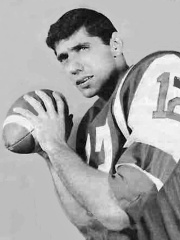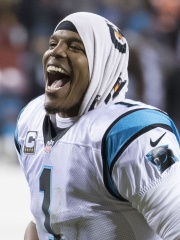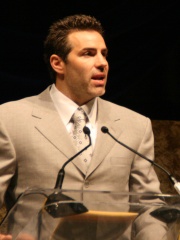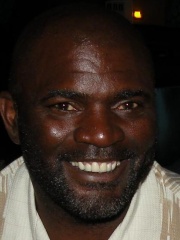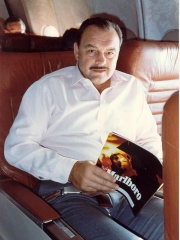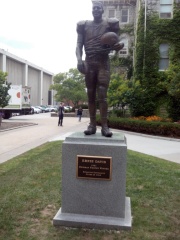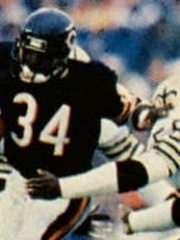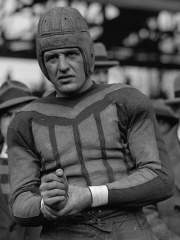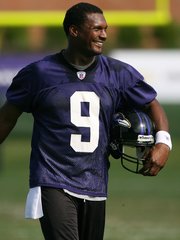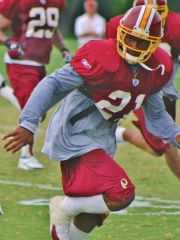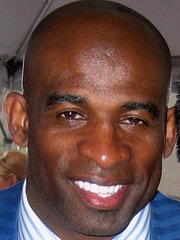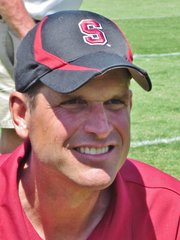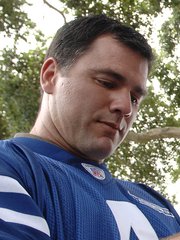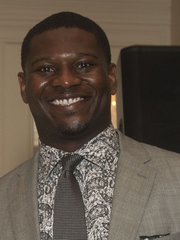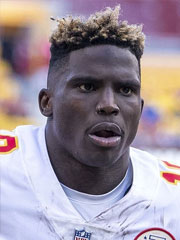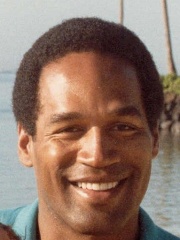
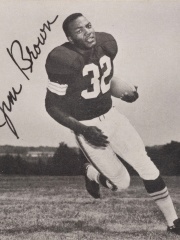



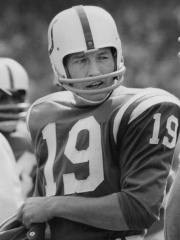
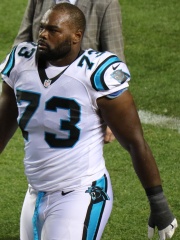
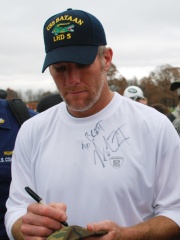
The Most Famous
AMERICAN FOOTBALL PLAYERS from United States
This page contains a list of the greatest American American Football Players. The pantheon dataset contains 63 American Football Players, 92 of which were born in United States. This makes United States the birth place of the most number of American Football Players.
Top 10
The following people are considered by Pantheon to be the top 10 most legendary American American Football Players of all time. This list of famous American American Football Players is sorted by HPI (Historical Popularity Index), a metric that aggregates information on a biography's online popularity. Visit the rankings page to view the entire list of American American Football Players.

1. O. J. Simpson (1947 - 2024)
With an HPI of 76.56, O. J. Simpson is the most famous American American Football Player. His biography has been translated into 56 different languages on wikipedia.
Orenthal James Simpson (July 9, 1947 – April 10, 2024), also known by his nickname "the Juice", was an American professional football player, actor, and media personality who played in the National Football League (NFL) for 11 seasons, primarily with the Buffalo Bills. Simpson is regarded as one of the greatest running backs of all time, but his success was overshadowed by his criminal trial and controversial acquittal for the murders of his former wife Nicole Brown and her friend Ron Goldman in 1994. Simpson played college football for the USC Trojans, where he won the Heisman Trophy as a senior, and was selected first overall by the Bills in the 1969 NFL/AFL draft. During his nine seasons with the Bills, he received five consecutive Pro Bowl and first-team All-Pro selections from 1972 to 1976. He also led the league in rushing yards four times, in rushing touchdowns twice, and in points scored in 1975. Simpson became the first NFL player to rush for more than 2,000 yards in a season, earning him NFL Most Valuable Player (MVP), and is the only NFL player to do so in a 14-game regular season. He holds the record for the single-season yards-per-game average at 143.1. He acquired the nickname "Juice" as a play on "OJ", a common abbreviation for orange juice. After retiring with the San Francisco 49ers in 1979, he acted in film and television, including in the Naked Gun franchise, became a sportscaster, and was a spokesman for a wide variety of products and companies, notably Hertz. He was inducted to the College Football Hall of Fame in 1983 and the Pro Football Hall of Fame in 1985. In June 1994, Simpson was charged with murdering Nicole Brown Simpson and Ronald Goldman after they were stabbed to death in Los Angeles. His eight-month murder trial received international publicity and exacerbated racial divisions in the U.S., culminating with his acquittal in October 1995. Three years later, he was found liable for the murders in a civil suit from the victims' families but paid little of the $33.5 million judgment. In 2007, Simpson was arrested in Las Vegas and charged with armed robbery and kidnapping. He was convicted the following year and sentenced to 33 years' imprisonment with a minimum of nine years without parole. Simpson served his sentence at the Lovelock Correctional Center in rural Nevada until being paroled and released in 2017. For the remainder of his life, he resided in Florida and Nevada.

2. Jim Brown (1936 - 2023)
With an HPI of 59.72, Jim Brown is the 2nd most famous American American Football Player. His biography has been translated into 39 different languages.
James Nathaniel Brown (February 17, 1936 – May 18, 2023) was an American professional football player, civil rights activist, and actor. He played as a fullback for the Cleveland Browns of the National Football League (NFL) from 1957 to 1965. Widely considered one of the greatest running backs of all time, as well as one of the greatest players in NFL history, Brown was selected to a Pro Bowl and All-Pro team every season he was in the league, and was recognized as the AP NFL Most Valuable Player three times. Brown won an NFL championship with the Browns in 1964. He led the league in rushing yards in eight out of his nine seasons, and by the time he retired, he held most major rushing records. In 1999, he was named the greatest professional football player ever by The Sporting News and the Associated Press. Brown earned unanimous All-America honors playing college football at Syracuse University, where he was an all-around player for the Syracuse Orangemen football team. The team later retired his number 44 jersey, and he was inducted into the College Football Hall of Fame in 1995. He is also widely considered one of the greatest lacrosse players of all time, and the Premier Lacrosse League MVP Award is named in his honor. Brown also excelled in basketball and track and field. In his professional career, Brown carried the ball 2,359 times for 12,312 rushing yards and 106 touchdowns, which were all records when he retired. He averaged 104.3 rushing yards per game and is the only player in NFL history to average over 100 rushing yards per game for his career. Brown was enshrined in the Pro Football Hall of Fame in 1971. He was named to the NFL's 50th, 75th, and 100th Anniversary All-Time Teams, composed of the best players in NFL history. Brown was honored at the 2020 College Football Playoff National Championship as the greatest college football player of all time. His number 32 jersey is retired by the Browns. Shortly before the end of his football career, Brown became an actor. He retired at the peak of his football career to pursue an acting career. He obtained 53 acting credits and several leading roles throughout the 1970s. He has been described as Hollywood's first black action hero and his role in the 1969 film 100 Rifles made cinematic history for featuring interracial love scenes. Brown was one of the few athletes, and among the most prominent African Americans, to speak out on racial issues as the civil rights movement was growing in the 1950s. He participated in the Cleveland Summit after Muhammad Ali faced imprisonment for refusing to enter the draft for the Vietnam War, and he founded the Black Economic Union to help promote economic opportunities for minority-owned businesses. Brown later launched a foundation focused on diverting at-risk youth from violence through teaching them life skills, through which he facilitated the Watts truce between rival street gangs in Los Angeles.

3. Tom Brady (b. 1977)
With an HPI of 58.43, Tom Brady is the 3rd most famous American American Football Player. His biography has been translated into 49 different languages.
Thomas Edward Patrick Brady Jr. (born August 3, 1977) is an American former professional football quarterback who played in the National Football League (NFL) for 23 seasons. He spent his first 20 seasons with the New England Patriots and was a central contributor to the franchise's dynasty from 2001 to 2019. In his final three seasons, he played for the Tampa Bay Buccaneers. Brady is widely regarded as the greatest quarterback of all time. After playing college football for the Michigan Wolverines, Brady was selected 199th overall by the Patriots in the sixth round of the 2000 NFL draft, later earning him a reputation as the NFL's biggest draft steal. He became the starting quarterback during his second season, which saw the Patriots win their first Super Bowl title in Super Bowl XXXVI. As the team's primary starter for 18 seasons, Brady led the Patriots to 17 division titles (including 11 consecutive from 2009 to 2019), 13 AFC Championship Games (including eight consecutive from 2011 to 2018), nine Super Bowl appearances, and six Super Bowl titles, all NFL records for a player and franchise. He joined the Buccaneers in 2020 and won Super Bowl LV, extending his individual records to ten Super Bowl appearances and seven victories. In 2024, Brady became the lead color commentator for the NFL on Fox and a partial owner of the Las Vegas Raiders. Brady holds many major quarterback records, including most career passing yards, completions, touchdown passes, and games started. He is the NFL leader in career quarterback wins, quarterback regular season wins, quarterback playoff wins, and Super Bowl Most Valuable Player (MVP) Awards, and the only Super Bowl MVP for two different franchises. Additional accolades held by Brady include the most Pro Bowl selections and the first unanimous NFL MVP. The only quarterback to win a Super Bowl in three separate decades, Brady is also noted for the longevity of his success. He was the oldest NFL MVP at age 40, the oldest Super Bowl MVP at age 43, and the oldest quarterback selected to the Pro Bowl at age 44. Brady is the only NFL quarterback named to two all-decade teams (2000s and 2010s) and was unanimously named to the 100th Anniversary All-Time Team in 2019.

4. Joe Montana (b. 1956)
With an HPI of 56.29, Joe Montana is the 4th most famous American American Football Player. His biography has been translated into 33 different languages.
Joseph Clifford Montana Jr. (born June 11, 1956) is an American former professional football quarterback who played in the National Football League (NFL) for 16 seasons, primarily with the San Francisco 49ers. Nicknamed "Joe Cool" and "the Comeback Kid", Montana is widely regarded as one of the greatest quarterbacks of all time. After winning a national championship with the Notre Dame Fighting Irish, Montana began his NFL career in 1979 at San Francisco, where he played for the next 14 seasons. With the 49ers, Montana started and won four Super Bowls and was the first player to be named the Super Bowl Most Valuable Player (MVP) three times. He also holds Super Bowl career records for most passes without an interception (122 in four games) and the all-time highest passer rating of 127.8. In 1993, Montana was traded to the Kansas City Chiefs, where he played for his last two seasons and led the franchise to its first AFC Championship Game. Montana was inducted to the Pro Football Hall of Fame in 2000. In 1986, Montana won the NFL Comeback Player of the Year Award after suffering a severe back injury during week one. In 1989 and again in 1990, Montana was named the NFL Most Valuable Player. Montana was elected to eight Pro Bowls as well as being voted first-team All-Pro in 1987, 1989, and 1990. Montana had the highest passer rating in the National Football Conference (NFC) five times (1981, 1984, 1985, 1987, and 1989), and in both 1987 and 1989, Montana had the highest passer rating in the NFL. Among his career highlights, "the Catch" (the game-winning touchdown pass to Dwight Clark vs. Dallas in the 1981 NFC Championship Game) and a Super Bowl-winning 92-yard drive against the Cincinnati Bengals in Super Bowl XXIII are staples of NFL highlight films. The 49ers retired Montana's No. 16 jersey number after the conclusion of his playing career. In 1994, Montana earned a spot on the NFL 75th Anniversary All-Time Team; he is also a member of the NFL 1980s All-Decade Team. In 1999, editors at The Sporting News ranked Montana third on their list of Football's 100 Greatest Players. Also in 1999, ESPN named Montana the 25th greatest athlete of the 20th century. In 2006, Sports Illustrated rated him the number-one clutch quarterback of all time. After his football career, Montana became a venture capitalist through his firm, Liquid 2 Ventures.
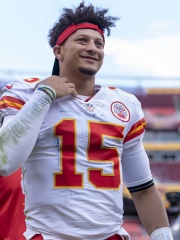
5. Patrick Mahomes (b. 1995)
With an HPI of 55.02, Patrick Mahomes is the 5th most famous American American Football Player. His biography has been translated into 30 different languages.
Patrick Lavon Mahomes II ( mə-HOHMZ; born September 17, 1995) is an American professional football quarterback for the Kansas City Chiefs of the National Football League (NFL). Since becoming the Chiefs' starting quarterback in 2018, he has led the team to seven consecutive AFC Championship Game appearances and five Super Bowl appearances, winning three. He is one of only five quarterbacks in NFL history to win three or more Super Bowls as a starter. Mahomes is widely regarded as one of the greatest quarterbacks of all time. He is often considered the best quarterback of his generation, with many outlets ranking him as the league's top player at the position. Mahomes played college football for the Texas Tech Red Raiders, winning the Sammy Baugh Trophy as a junior after leading the FBS in passing yards and total touchdowns. He was selected 10th overall by the Kansas City Chiefs in the 2017 NFL draft and spent his rookie season as the backup to Alex Smith. In 2018, after the Chiefs traded Smith, Mahomes became the starter and threw for 5,097 yards, 50 touchdowns, and 12 interceptions. He became the first quarterback to achieve over 5,000 passing yards in both college and the NFL, and joined Peyton Manning as the only players to record 5,000 passing yards and 50 touchdowns in an NFL season. For his performance in his first season as a starter, he won the NFL Offensive Player of the Year and NFL Most Valuable Player awards, becoming one of four black quarterbacks to win the AP MVP award. In the 2019 season, Mahomes led the Chiefs to their first Super Bowl in 50 years, winning Super Bowl LIV. Mahomes was awarded the Super Bowl MVP for his performance, becoming the youngest quarterback and the second Black quarterback to earn the honor. In 2020, Mahomes signed a 10-year contract extension worth over $450 million, making it one of the largest contracts in sports history. That season, the Chiefs returned to the Super Bowl but lost in Super Bowl LV. In the 2022 season, Mahomes led the league in passing yards and touchdowns, won NFL MVP, and earned Super Bowl MVP after winning Super Bowl LVII. He won his third Super Bowl MVP after winning Super Bowl LVIII the following year, leading the Chiefs to back-to-back titles. In the 2024 season, he led the Chiefs to their third straight Super Bowl but lost Super Bowl LIX, falling short of a historic three-peat.

6. Dan Marino (b. 1961)
With an HPI of 52.28, Dan Marino is the 6th most famous American American Football Player. His biography has been translated into 30 different languages.
Daniel Constantine Marino Jr. ( mə-REE-noh; born September 15, 1961) is an American former professional football quarterback who played in the National Football League (NFL) for 17 seasons with the Miami Dolphins. He played college football for the Pittsburgh Panthers, earning first-team All-American honors in 1981. Marino was the last quarterback taken in the first round of the famed quarterback class of 1983. He held or currently holds dozens of NFL records associated with the quarterback position, and despite never being on a Super Bowl-winning team, he is recognized among the greatest quarterbacks in American football history. Best remembered for his quick release and powerful arm, Marino helped the Dolphins become consistent postseason contenders, leading them to the playoffs ten times and one Super Bowl appearance in XIX, although a title victory ultimately eluded him during his career. Marino is considered by many to be one of the greatest players to never win a Super Bowl and has the most career victories of quarterbacks not to win a title at 155. A nine-time Pro Bowl selection, six-time first (3) or second (3) team All-Pro, and All-AFC six times, Marino was voted NFL Rookie of the Year by Sporting News. The following season in 1984, Marino was the NFL Most Valuable Player (MVP), when he set single-season records of 5,084 passing yards, 48 touchdown passes, nine 300-yard passing games, and four 400-yard passing games. He was voted the 1994 NFL Comeback Player of the Year, and the 1998 NFL Walter Payton Man of the Year. At the time of his retirement, Marino held more than 40 NFL single-season and career passing records (many of which have since been surpassed), including career passing attempts (8,358), completions (4,967), passing yards (61,361), and touchdown passes (420). His career passer rating of 86.4 was the fourth-highest in NFL history (fifth when including stats from the AAFC). Marino was the first quarterback in NFL history to reach 5,000 yards passing in a season (1984); 50,000 and 60,000 career passing yards respectively, and also the first quarterback to reach 40-plus touchdown passes in a season (48 in 1984), and 400 career touchdown passes. Marino was enshrined into the Miami Dolphins Honor Roll immediately after his retirement in 2000, inducted into the College Football Hall of Fame in 2003, inducted into the Pro Football Hall of Fame in 2005 in his first year of eligibility, and is currently one of only three former Miami Dolphins to have his jersey number retired. In 2019, Marino was named to the NFL 100th Anniversary All-Time Team as one of the 10 greatest quarterbacks in NFL history, as determined by a panel of coaches and media members.

7. Johnny Unitas (1933 - 2002)
With an HPI of 51.78, Johnny Unitas is the 7th most famous American American Football Player. His biography has been translated into 30 different languages.
John Constantine Unitas (; May 7, 1933 – September 11, 2002) was an American professional football quarterback who played in the National Football League (NFL) for 18 seasons, primarily with the Baltimore Colts. Nicknamed "Johnny U." and "the Golden Arm", Unitas was considered the prototype of the modern era marquee quarterback and is regarded as one of the greatest NFL players of all time. During his professional career from 1956 to 1973, Unitas set many NFL records and was named Most Valuable Player three times in 1959, 1964, and 1967, in addition to receiving 10 Pro Bowl and five first-team All-Pro honors. He helped lead the Colts to four championship titles; three in the pre-merger era in 1958, 1959, and 1968, and one in the Super Bowl era in Super Bowl V. His first championship victory is regarded as one of the league's greatest games and is credited with helping popularize the NFL. Between 1956 and 1960, he set the record for most consecutive games with a touchdown pass at 47, which held for 52 years. Unitas is one of only six players to be named to the NFL's 50th, 75th and 100th Anniversary All-Time Teams. He led the league in fourth quarter comebacks in six seasons, more than any other quarterback, and is praised for his development of the hurry-up offense. Unitas was inducted to the Pro Football Hall of Fame in 1979.

8. Michael Oher (b. 1986)
With an HPI of 51.54, Michael Oher is the 8th most famous American American Football Player. His biography has been translated into 22 different languages.
Michael Jerome Oher (; né Williams Jr.; born May 28, 1986) is an American former professional football tackle who played in the National Football League (NFL) for eight seasons. He played college football for the Ole Miss Rebels, earning unanimous All-American honors and winning the Jacobs Blocking Trophy in 2008. Oher was selected in the first round of the 2009 NFL draft by the Baltimore Ravens, where he spent his first five seasons and was a member of the team that won Super Bowl XLVII. He later played one season for the Tennessee Titans and his final two for the Carolina Panthers. Oher's life through his final year of high school and first year of college is one of the subjects of Michael Lewis's 2006 book The Blind Side: Evolution of a Game and was dramatized in the 2009 film adaptation.

9. Brett Favre (b. 1969)
With an HPI of 50.66, Brett Favre is the 9th most famous American American Football Player. His biography has been translated into 29 different languages.
Brett Lorenzo Favre ( FARV; born October 10, 1969) is an American former professional football quarterback who played in the National Football League (NFL) for 20 seasons, primarily with the Green Bay Packers. Favre had 321 consecutive starts from 1992 to 2010, including 297 regular season games, the most in league history. He was also the first NFL quarterback to obtain 70,000 yards, 10,000 passes, 6,000 completions, 500 touchdowns, and victories over all 32 teams. Favre played college football for the Southern Mississippi Golden Eagles and was selected in the second round of the 1991 NFL draft by the Atlanta Falcons, where he spent one season as a backup. Traded to the Packers, he became their starter early in the 1992 season and revitalized a franchise which had been in a period of decline since the late 1960s. During his 16 seasons with Green Bay, he led the team to 11 playoff appearances, seven division titles, four NFC Championship Games, two consecutive Super Bowl appearances, and one championship title in Super Bowl XXXI, the team's first in nearly three decades. Favre was traded in 2008 to the New York Jets, where he played one year, and spent his final two seasons with the Minnesota Vikings. His 2009 campaign for the Vikings saw him guide them to a division title and NFC Championship Game appearance, while having one of his strongest statistical seasons. At the time of his retirement, Favre was the NFL leader in passing completions, passing attempts, passing yards, passing touchdowns, and quarterback wins. He continues to hold the record for career interceptions with 336. From 1995 to 1997, he was named Most Valuable Player three times, the most the award was consecutively received. Favre also received 11 Pro Bowl and three first-team All-Pro selections. He was inducted to the Pro Football Hall of Fame in 2016. In 2022, Favre began to face controversy for the Mississippi welfare funds scandal after investigations determined $8 million intended for welfare programs went to Favre or causes he championed. Favre has denied the allegations and filed a defamation lawsuit against the State Auditor of Mississippi and two media personalities over their coverage of him.
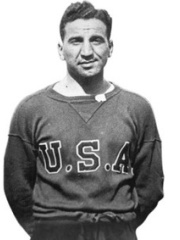
10. Aldo Donelli (1907 - 1994)
With an HPI of 50.56, Aldo Donelli is the 10th most famous American American Football Player. His biography has been translated into 16 different languages.
Aldo Teo "Buff" Donelli (July 22, 1907 – August 9, 1994) was an American football player and coach, soccer player, and college athletics administrator. He served as the head football coach at Duquesne University from 1939 to 1942, Boston University from 1947 to 1956, and Columbia University from 1957 to 1967, compiling a career college football coaching record of 105–107–8. Donelli was also a head coach in the National Football League (NFL), with the Pittsburgh Steelers for part of the 1941 season and with the Cleveland Rams in 1944, tallying a career mark of 4–11 in the NFL. From 1951 to 1955 he was the athletic director at Boston University. Donelli played college football at Duquesne and was an assistant football coach at his alma mater from 1930 to 1938, before being promoted to head coach. He played soccer with a number of clubs in the 1920s and 1930s and was a member of the United States men's national soccer team during the 1934 FIFA World Cup. He is a member of the National Soccer Hall of Fame.
People
Pantheon has 92 people classified as American american football players born between 1903 and 1999. Of these 92, 80 (86.96%) of them are still alive today. The most famous living American american football players include Tom Brady, Joe Montana, and Patrick Mahomes. The most famous deceased American american football players include O. J. Simpson, Jim Brown, and Johnny Unitas. As of April 2024, 28 new American american football players have been added to Pantheon including Deion Sanders, Reggie White, and Jim Harbaugh.
Living American American Football Players
Go to all RankingsTom Brady
1977 - Present
HPI: 58.43
Joe Montana
1956 - Present
HPI: 56.29
Patrick Mahomes
1995 - Present
HPI: 55.02
Dan Marino
1961 - Present
HPI: 52.28
Michael Oher
1986 - Present
HPI: 51.54
Brett Favre
1969 - Present
HPI: 50.66
Joe Namath
1943 - Present
HPI: 50.45
Peyton Manning
1976 - Present
HPI: 49.89
Cam Newton
1989 - Present
HPI: 49.72
Jerry Rice
1962 - Present
HPI: 49.49
Kurt Warner
1971 - Present
HPI: 48.86
Lawrence Taylor
1959 - Present
HPI: 48.37
Deceased American American Football Players
Go to all RankingsO. J. Simpson
1947 - 2024
HPI: 76.56
Jim Brown
1936 - 2023
HPI: 59.72
Johnny Unitas
1933 - 2002
HPI: 51.78
Aldo Donelli
1907 - 1994
HPI: 50.56
Dick Butkus
1942 - 2023
HPI: 49.86
Ernie Davis
1939 - 1963
HPI: 48.45
Walter Payton
1954 - 1999
HPI: 47.71
Red Grange
1903 - 1991
HPI: 45.35
Aaron Hernandez
1989 - 2017
HPI: 44.37
Reggie White
1961 - 2004
HPI: 41.92
Steve McNair
1973 - 2009
HPI: 39.10
Sean Taylor
1983 - 2007
HPI: 34.50
Newly Added American American Football Players (2025)
Go to all RankingsDeion Sanders
1967 - Present
HPI: 45.22
Reggie White
1961 - 2004
HPI: 41.92
Jim Harbaugh
1963 - Present
HPI: 41.62
Steve McNair
1973 - 2009
HPI: 39.10
Willie Gault
1960 - Present
HPI: 38.42
Josh Allen
1996 - Present
HPI: 36.33
Kirk Cousins
1988 - Present
HPI: 36.05
Adam Vinatieri
1972 - Present
HPI: 35.56
LaDainian Tomlinson
1979 - Present
HPI: 33.66
Matthew Stafford
1988 - Present
HPI: 32.85
Tyreek Hill
1994 - Present
HPI: 32.69
Justin Tucker
1989 - Present
HPI: 32.03
Overlapping Lives
Which American Football Players were alive at the same time? This visualization shows the lifespans of the 12 most globally memorable American Football Players since 1700.

